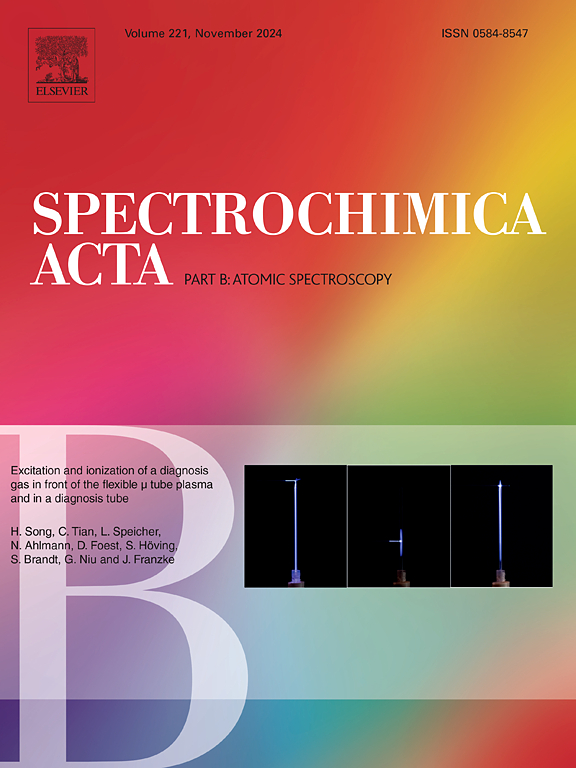UiO-66-NH2@tannic acid-assisted solid-phase extraction combined with laser-induced breakdown spectroscopy for sensitive detection of Pb (II) in aquatic products
IF 3.2
2区 化学
Q1 SPECTROSCOPY
引用次数: 0
Abstract
In this work, a novel method for sensitive detecting heavy metal Pb (II) in aquatic products was developed using UiO-66-NH2@tannic acid (UiO-66-NH2@TA) solid-phase extraction combined with laser-induced breakdown spectroscopy (LIBS). UiO-66-NH2@TA adsorbent could effectively extract Pb (II) from the digestive solution of aquatic products. Characterization of the morphology of the adsorbent was performed using transmission electron microscopy and scanning electron microscopy. The optimal experimental conditions for LIBS detection, including sample preparation, substrate type, laser energy, and delay time, were investigated. The results showed that the strongest Pb I 405.7 nm spectral signal can be obtained by dripping UiO-66-NH2@TA adsorbent onto a silicon wafer for LIBS testing. The limit of detection and limit of quantification for Pb (II) in aqueous solution were 0.18 μg/mL and 0.61 μg/mL, respectively. The calibration curve demonstrated good sensitivity and accuracy for Pb (II) detection with a correlation coefficient of 0.9905. Spiked recovery experiments on large yellow croakers and scallops yielded recovery rates of 75.25 % - 99.08 %, which was consistent with the results from atomic absorption spectrometry. This study underscores the potential of the solid-phase extraction combined with laser-induced breakdown spectroscopy for practical application in food safety monitoring, demonstrating its effectiveness and reliability in detecting Pb (II) in aquatic products.

求助全文
约1分钟内获得全文
求助全文
来源期刊
CiteScore
6.10
自引率
12.10%
发文量
173
审稿时长
81 days
期刊介绍:
Spectrochimica Acta Part B: Atomic Spectroscopy, is intended for the rapid publication of both original work and reviews in the following fields:
Atomic Emission (AES), Atomic Absorption (AAS) and Atomic Fluorescence (AFS) spectroscopy;
Mass Spectrometry (MS) for inorganic analysis covering Spark Source (SS-MS), Inductively Coupled Plasma (ICP-MS), Glow Discharge (GD-MS), and Secondary Ion Mass Spectrometry (SIMS).
Laser induced atomic spectroscopy for inorganic analysis, including non-linear optical laser spectroscopy, covering Laser Enhanced Ionization (LEI), Laser Induced Fluorescence (LIF), Resonance Ionization Spectroscopy (RIS) and Resonance Ionization Mass Spectrometry (RIMS); Laser Induced Breakdown Spectroscopy (LIBS); Cavity Ringdown Spectroscopy (CRDS), Laser Ablation Inductively Coupled Plasma Atomic Emission Spectroscopy (LA-ICP-AES) and Laser Ablation Inductively Coupled Plasma Mass Spectrometry (LA-ICP-MS).
X-ray spectrometry, X-ray Optics and Microanalysis, including X-ray fluorescence spectrometry (XRF) and related techniques, in particular Total-reflection X-ray Fluorescence Spectrometry (TXRF), and Synchrotron Radiation-excited Total reflection XRF (SR-TXRF).
Manuscripts dealing with (i) fundamentals, (ii) methodology development, (iii)instrumentation, and (iv) applications, can be submitted for publication.
文献相关原料
公司名称
产品信息
麦克林
Zirconium chloride (ZrCl4)
麦克林
N,N-dimethylformamide (DMF)
麦克林
Sodium hydroxide (NaOH)
阿拉丁
Tannic acid (TA)

 求助内容:
求助内容: 应助结果提醒方式:
应助结果提醒方式:


